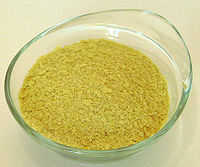- Nutritional yeast
-
Nutritional yeast is a deactivated yeast, usually Saccharomyces cerevisiae.[1] The scientific work of Louis Pasteur made it possible to isolate yeast in pure culture form.[2] Nutritional yeast is produced by culturing the yeast with a mixture of sugarcane and beet molasses for a period of 7 days and then harvesting, washing, drying and packaging it. It is commercially available in the form of flakes or as a yellow powder similar in texture to cornmeal, and can be found in the bulk aisle of most natural food stores. It is popular with vegans and vegetarians and may be used as an ingredient in recipes or as a condiment.[3]
It is a source of protein and vitamins, especially the B-complex vitamins, and is a complete protein. It is also naturally low in fat and sodium and is free of sugar, dairy, and gluten. Some brands of nutritional yeast, though not all, are fortified with vitamin B12. When fortified, the vitamin B12 is produced separately (commonly Cyanocobalamin) and then added to the yeast.[citation needed]
Nutritional yeast has a strong flavor that is described as nutty, cheesy, or creamy, which makes it popular as an ingredient in cheese substitutes. It is often used by vegans in place of parmesan cheese. Another popular use is as a topping for popcorn, typically paired with pickles. It can also be used in mashed and fried potatoes, as well as put into scrambled tofu or eggs. Some movie theaters offer it along with salt or cayenne pepper as a popcorn condiment.[citation needed]
In Australia it is sometimes sold as "savoury yeast flakes." In New Zealand, it has long been known as Brufax. In the United States it is sometimes referred to as "nooch", or "yeshi," an Ethiopian name meaning "for a thousand". Though "nutritional yeast" usually refers to commercial products, inadequately fed prisoners of war have used "home-grown" yeast to prevent vitamin deficiency.[4] Nutritional yeast is different from yeast extract, which has a very strong flavour and comes in the form of a dark brown paste. Other strains of Saccharomyces cerevisiae are commonly used for making beer, wine, and bread.
Contents
Glutamic acid
Nutritional yeast products do not have any added monosodium glutamate; however, all inactive yeast contains a certain amount of free glutamic acid because when the yeast cells are killed the protein that comprises the cell walls begins to degrade, breaking down into the amino acids that originally formed it. Glutamic acid is a naturally occurring amino acid in all yeast cells, as well as in many vegetables, fungi and meats. High-temperature nutritional yeast products apparently yield elevated concentrations of the excitotoxin glutamate as a by-product.[citation needed]
Glucose Tolerance Factor (GTF)
Nutritional yeast, unlike Brewers yeast, does not contain chromium, an essential mineral that was identified as the active component of Glucose Tolerance Factor (GTF).[5] Chromium is found in the adrenal glands, brain, fat, muscle, and skin. Chromium as GTF improves glucose tolerance in diabetics[6] because insulin is better bridged to cell membranes.
See also
References
- ^ Melissa G. Benefits of Nutritional Yeast. "Wellsphere." 13 September 2008.
- ^ Orfano, Finn. The Benefits of Nutritional Yeast. "Bright Hub" 12 October 2010.
- ^ Brown, Elizabeth. Singing the praises of nutritional yeast. Santa Monica Daily Press. 25 April 2009.
- ^ J G Lee HARUKOE (HARUKU)
- ^ "Chromium" University of Maryland 18 March 2011
- ^ Saul, Andrew W. "20 way to make progress against diabetes" "Doctor Yourself"
External links
Categories:- Condiments
- Food additives
- Umami enhancers
- Vegan cuisine
- Yeasts
Wikimedia Foundation. 2010.


